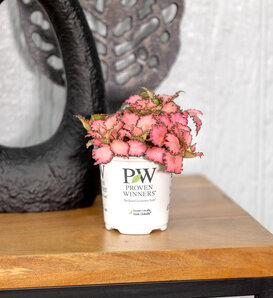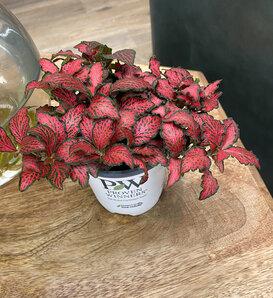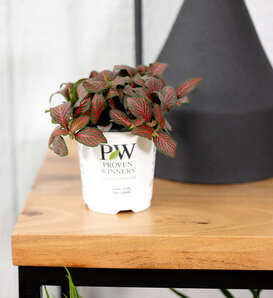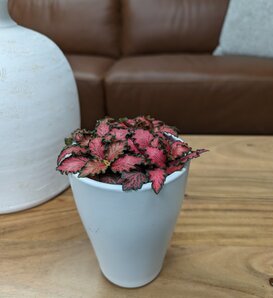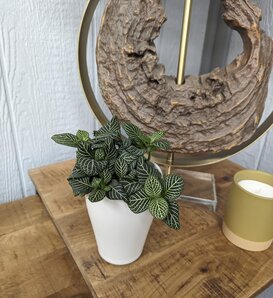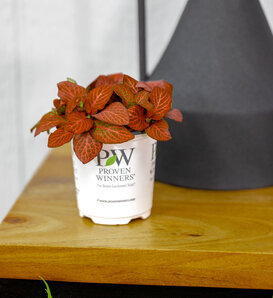This plant is absolutely beautiful, love the stark contrast between the white and deep green of the leaves. Grows very well with little to no effort. Great for beginners or anyone else who wants something for their friends to compliment!
Network News™ All the Time™ Nerve Plant Fittonia albivenis
Select any icon above to view the complete collection.
Learn more about Proven Winners® leafjoy® houseplants
- Low
- Medium
- High
-
Details
4 - 8 Inches0 -0 -10cm - 20cm0cm0cmFeatures
Here’s another lovely Fittonia worthy of bringing verdant style into your space ‘All the Time!’ Like other nerve plants, this is a low-growing, creeping plant with small, ovate leaves. ‘All the Time’ is adorned in a flawless fishnet-pattern of white veining.
Adaptable As HouseplantFoliage InterestHarmful To:PetsCharacteristics
Plant Type:HouseplantHeight Category:ShortHeight:4 - 8 Inches 10cm - 20cmFoliage Colors:GreenFoliage Colors:WhiteFoliage Shade:Green with white veinsHabit:SpreadingContainer Role:SpillerPlant Needs
Light Requirement:HighLight Requirement:LowLight Requirement:MediumLow - No direct sun, not near a window. Medium - Medium bright indirect light in the AM or PM, typically from an east or west window. High - Bright direct or indirect light for much of the day, typically from a south window.
Maintenance Category:ModeratePreferred Temperature:60 - 85 °FWater Category:AverageHumidity Preference:HighContainer Soil Type:Indoor Potting MixNeeds Good DrainageUses:Bright SpacesUses:DesktopsUses:Humid SpacesUses:North Facing WindowsUses Notes:Not for human or animal consumption.
Maintenance Notes:- For optimal performance, keep your Nerve Plant at 60-85°F (15-29°C).
- Nerve Plants perform best in bright indirect light, such as within a few feet of a north or east facing window. Avoid placing them next to a window that gets direct sunlight, unless it is early in the morning, or late in the afternoon. Direct midday sun can cause burnt leaf edges. If you notice your Nerve Plant is getting leggy, it is stretching out for more light, and should be moved to a brighter location. Your Nerve Plant may benefit from being rotated periodically, to ensure even distribution of light and even growth. Nerve Plants can survive in lower light conditions, however, they will not flourish & flush out new growth.
- Nerve Plants are aficionados of high humidity. To keep humidity at around 60% or higher, you may need to position your Nerve Plant near a humidifier or under glass. Placing it on a pebble tray, misting it regularly, or surrounding it with other plants may also help to increase its humidity.
- Nerve Plants prefer to have moist, but not soggy soil. As such, water when the top inch of soil is dry, but do not allow it to fully dry out or you may notice it wilting or “fainting”. Once the soil is moist, allow your Nerve Plant to drain thoroughly, as it should not sit in standing water for extended periods of time.
- Feed your Nerve Plant once per month at half strength when it is actively growing. Reduce frequency of fertilization in the winter months. If no new leaves are growing, it does not need to be fertilized.
- Protect furniture when watering & fertilizing.
- When repotting your Nerve Plant, use an all-purpose potting mix, with additional orchid bark and perlite added, to ensure it has good drainage and plenty of nutrients.
- Nerve Plants do require more care than other houseplants, as they require consistent levels of light, temperature, and humidity to keep them thriving. Their leaves will be a good indicator of what they may need:
- Drooping, wilting leaves + dry soil = more water needed.
- Yellowing leaves + soggy soil = less water needed or more drainage needed.
- Leaves dropping = could be an indication that they are in a drafty or cold spot.
- Drying, browning leaves & tips = could be an indication that they are receiving too much direct sunlight or not enough humidity.
-
1 Review
-
11 More colors





